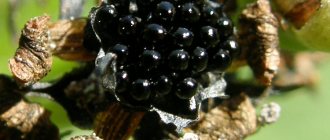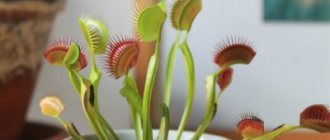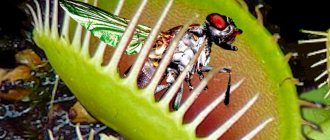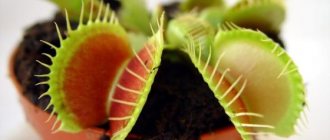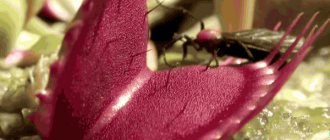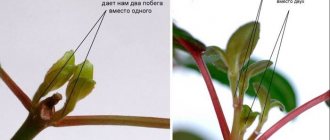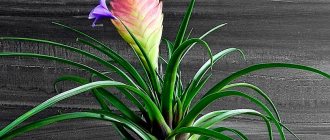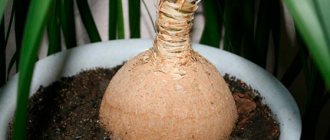Description
The Venus flytrap is a small herbaceous plant. The leaf blades of a representative of the Sundew family grow from a short underground stem. The length of the foliage reaches 3–7 cm. The upper part of the trap is painted with pigments that give it a reddish tint that attracts insects. The flowers, located at the tips of the stems, are quite small. Their outlines resemble the shape of a star. The average lifespan of a plant is 6–7 years. Looking through the photo, gardeners pay attention to how unusual the plant looks.
What does dionaea look like?
Do you want to buy a carnivorous house plant? Buy a carnivorous herbaceous flower - Dionaea. It belongs to the sundew family, consisting of one species. The height of an adult plant is about 15 cm. When Dionaea blooms, it throws out a tall white corymbose-type inflorescence.
Under natural conditions, Dionaea grows in soil depleted of nitrogen. To replenish this substance, the Venus flytrap catches insects with its petal flaps and processes them. The stem, located underground, grows from the bulb. The basal rosette consists of 4-7 leaves.
Reddish trap petals up to 15 cm long; they consist of two valves. There are sparse bristles along the outer edge of the petal. Inside the trap there are glands capable of producing nectar. It is designed to attract insects.
The valves in the petals close due to sensitive hairs. They react with lightning speed to the slightest movement of any insect and slam shut. Once it is inside the trap, digestion begins with the help of an enzyme. It lasts about 7-10 days. At the end of the process, the trap opens the doors again. After eating three insects, the petal dies.
Caring for a Venus flytrap at home
Caring for a Venus flytrap at home is not difficult. The most important thing is to provide the plant with the correct conditions, namely: timely watering and replanting, acceptable temperature, and humidity level.
Location and lighting
Flower growers recommend placing containers with dionaea on window sills located on the west or east side of the house. The plant needs fresh air, so it is important to systematically ventilate the room. In the warm season, you can take flowers out into the garden.
Flower content temperature
In summer, the temperature in the room where flowers are grown should be within +25...+35 °C. In the cold season, you can reduce the temperature to +5...+7 °C. The Venus flytrap (Dionea) needs a period of rest.
Watering
The plant can only be watered with rain or distilled water at room temperature. It is unacceptable to use tap water to moisten the soil. The soil for the Venus flytrap should always remain slightly moist. On hot days, it is recommended to systematically spray the insectivorous crop.
Soil and pot
To prepare the soil substrate, you will need to mix peat with quartz sand and perlite (2:1 ratio). The sand is first doused with boiling water, and the perlite is kept in water for 5–7 days (the water needs to be changed daily). The Venus flytrap flower is not planted in nutritious soil so that the plant does not get sick.
The container for planting dionaea must be deep, because the root system penetrates 20 cm deep. The diameter of the pot can reach 10–12 cm. It is worth purchasing containers of a light shade, since dark colors attract sunlight, which causes overheating of the roots.
Planting and replanting Dionaea
It is advisable to carry out planting work in the first weeks of March, when active growth is just beginning. Depending on the size of the plant, you need to select the size of the pot. Dionaea is placed in a container filled with peat and sand. The soil mixture is moistened abundantly. The pot is moved to a well-lit place.
Venus flytraps are replanted annually. The main goal is soil renewal. Over time, the soil deoxidizes, so it is important to regularly replace the old soil mixture with a fresh substrate with the required acidity level.
Venus flytrap blooming
The flowering period of the Venus flytrap begins in May-June. Small flowers, painted white, form at the tops of the shoots. If it is important to achieve maximum development of traps, it is worth removing shoots with flowers. In addition, such actions can stimulate the appearance of daughter rosettes.
Fertilizers and fertilizers
The Venus flytrap is a carnivorous plant that can absorb essential elements from its prey. The flower does not need any other fertilizing.
During periods of active growth, a few small flies/mosquitoes/spiders will be enough for the crop. If Dionaea grows in the garden, it will attract prey on its own. For flowers that are grown indoors, you will need to first catch insects and launch them towards the predator.
Winter dormancy period
The plant annually needs a period of rest, the duration of which reaches 2–5 months. If the dormant period lasted less than 8 weeks, growth activity will be reduced.
Feeding
When purchasing Dionaea, be prepared for the fact that it will have to be regularly fed with insects. When kept at home, she has no one to attract with her fragrant death traps. Please note that the following are absolutely not suitable for feeding:
- Beetles with a hard chitinous cover.
- Earthworms.
- Small rodents and chicks.
- Food from your table, such as sausage, meat, any crumbs.
The plant is not able to digest them, and rotting remains can easily cause the death of the traps or even the death of the entire plant.
The Venus flytrap is fed small spiders, flies and mosquitoes. The frequency of feeding is 2-3 weeks, depending on the age and appetite of the plant. The optimal size of the prey should be ½ the size of the trap, otherwise the Dionaea will not be able to digest or hold it.
Remember that the insect must be alive!
When feeding, you need to place food in different traps each time. Feeding takes a lot of effort and time, the plant may not have time to restore them. After opening the trap, you need to carefully inspect it and remove any remaining undigested food.
It is best to grow Dionaea in a small aquarium. Then you can introduce insects to it and cover it with a lid for a while so that the predator has lunch on its own.
Do not feed Dionaea from September to March, during the dormant period, so that it does not waste energy. Also, you should not offer to hunt newly transplanted, sick or weakened plants. Dionea, digesting its prey, receives nitrogen from it, which does not bring anything good to any plants during hibernation.
What to feed the flycatcher?
When growing a Venus flytrap, there is no need to add fertilizer to the substrate, since it receives the necessary substances from digested insects.
So, what to feed the flycatcher? If there are none in the room where the flower grows, it should be fed flies, mosquitoes, and spiders on its own. You should not give the plant larvae, earthworms, meat, bloodworms, because they are poorly digested by traps, which causes them to rot. As a rule, the flycatcher digests food from 5 to 10 days. From the end of September there is no need to feed the flower.
Venus flytrap caught a fly
Reproduction of Venus flytrap
There are many ways to propagate this insectivorous crop. Below you can find out more about each of them.
Cuttings
For propagation, take a cutting without a trap. After that:
- The container is filled with a mixture of peat and perlite.
- The cuttings are planted at an angle.
- Peat is moistened abundantly.
- The pot is transferred to a well-lit greenhouse where the humidity level reaches 90%.
The appearance of sprouts is expected within 3–4 weeks.
Department of baby bulbs
Every 3 years, during transplantation, the daughter bulbs can be separated from the dionaea. It is not recommended to separate a large number of children so that the culture does not weaken.
Seeds
To grow a Venus flytrap from seeds, you will need to purchase planting material from a specialized store. Seeds are planted in a greenhouse. The beds are first covered with a layer of substrate, which consists of 70% sphagnum moss and 30% sand.
Step-by-step landing algorithm:
- 10 minutes before planting, the seeds are treated with a solution of the Topaz preparation.
- The seeds are placed in the substrate. Sprinkling with soil is not necessary.
- Using a spray bottle, moisten the soil abundantly.
- The bed is covered with a film, which can be removed only after the seedlings have formed 2 leaf plates. Until this time, the film is removed daily for 10 minutes for ventilation.
Peduncle
Peduncles take away strength from the plant, so it is recommended to periodically cut them off. This must be done while he is still small. The peduncle is used as a cutting, rooted and a Venus flytrap is grown from it at home.
Vegetative propagation
Vegetative propagation is their preferred method if you want to preserve the characteristics of a particular plant, say a cultivar or other unique specimen, because any flowers born from vegetative propagation will be genetically identical to the parent plant. Additionally, the amount of time it takes for a plant to reach maturity is typically one to two years, compared to the three to five years it takes to raise a plant from seed to maturity. The two easiest ways to vegetatively propagate your Venus fly trap are actually quite simple.
Two main methods of vegetative propagation of traps:
- Leaf traction devices.
- Multiple growth points.
Leaf traction devices
To remove leaves from a flower, you must uproot the plant and expose the rhizome. Next, you should look for the leaf that is on the outside of the rhizome. Firmly grasp the leaf and gently pull it down. The goal here is to try to get as much of the white part of the rhizome where the leaf is attached to the main plant as possible. Trim the trap from the leaf and place it in the soil you normally use for traps.
It is important to note that leaf pulling should only be done on healthy plants and not on any that are flowering. You can do leaf pulling with a diseased flower, but the success rate will be lower than with a healthy one.
Peduncle
Once you cut the stem as close to the base as possible where it grows from the center of the plant, if you stick the base of the flower stem into the ground, it will likely start to grow where it touches the soil.
Multiple points of growth through natural division
The easiest way to propagate fly traps is to simply let them grow. The flowers naturally reproduce, forming a second growing point in their rosette.
In the spring, when you go to replant your Venus fly trap, you can separate these two rosettes. If the new rosette has not had a chance to form its own root system, then it is best to leave the two plants together for another year until the new flower has a chance to take root. Separating two plants too early can result in the death of the new plant.
Diseases
Against the backdrop of an excessively high level of humidity, sooty fungus and gray rot can form on perennial bushes. You can rid the plant of them by treating them with a fungicidal agent (Topaz and Chorus). By following the recommendations for caring for Venus flytraps at home, you can prevent the development of these diseases.
Dionaea also often suffers from bactericidal damage, which develops in cases where the culture cannot digest the caught prey. If this happens, you need to cut off the problematic trap and spray the Venus flytrap with a fungicide.
Diseases and pests
The Venus flytrap is a plant with good immunity. Pests and diseases can only affect it if it is not properly cared for. The main ones:
- Gray rot. Occurs if the soil is too wet and the room temperature is low. It appears as a gray fluff on any part of the plant. Treated with fungicides and adjustments to maintenance conditions.
- Sooty fungus. Its sign is a black coating on the leaves. The reasons for the appearance are lack of fresh air, increased temperature and humidity, and the presence of insect pests. The control method is to remove infected areas and parasites, lowering air humidity.
- Bactericidal defeat. Caused by the fact that the trap was unable to digest the caught insect. The sign is its blackening and death. Damaged parts are removed and the plant is treated with a fungicide.
- Spider mite. Cobwebs appear on the leaf petioles. The plant is treated with acaricides and the humidity of the surrounding air is increased.
- Aphid. Its appearance leads to deformation of the traps. The control method is irrigation with insecticides.
Pests
The insectivorous plant often suffers from an invasion of pests, as a result of which its trapping apparatus is deformed. Quite often aphids appear in traps. To cope with aphids, it is recommended to treat the perennial with an insecticidal agent.
Growing Dionaea is very exciting. Caring for a Venus flytrap is not difficult, so even a novice gardener can handle it. But in order for the plant to be healthy, it is important to create suitable conditions for it. By providing the crop with proper care, you can grow a healthy flower, the growth of which will be interesting for all family members to watch.
Reproduction of Dionaea
The Venus flytrap can be propagated, like other types of indoor crops, in various ways: both vegetatively and using seed material. Let's consider all the options.
Baby bulbs
This process does not require knowledge. Flower growers use it much more often than other propagation options. This method is applied once every three years.
The Venus flytrap is a family plant that simply loves to grow surrounded by baby bulbs. If they are often separated from the mother bush, the Dionaea will noticeably weaken. This fact should be taken into account. Therefore, planting work is always combined with bulb separation to reduce stress on the plant.
Use a sharp knife to separate the baby from the bush without causing injury to the fragile root system of the flytrap. After separation, the bulb and the cut site on the bush must be treated with a disinfectant. Any fungicide or crushed activated carbon is suitable for this.
Seeds
Reproduction of flycatchers using seed material is a labor-intensive and complex process. Do you want to grow this exotic carnivorous plant in your apartment? Then be patient and gain some experience. This is where it comes in handy.
The seeds are sown in early spring; it is during this period that this exotic crop begins to bloom. Moreover, fresh seeds will not sprout. Planting material is first subjected to a stratification process: soaking the seeds for a long time, holding them at certain temperatures.
The stratification process is as follows:
- Soak a gauze pad with Topaz solution to stimulate growth, then lightly squeeze out excess water;
- Spread the seeds on it and wrap it in gauze;
- The bundle is placed in a plastic bag and sent to the bottom shelf of the refrigerator;
- The seed material is kept in the cold for 1.5-2 months.
Every week the bundle is unrolled for ventilation. If a mold film is detected, the seed material is washed in a fungicide. When the stratification process is completed, you can begin sowing.
Peduncles
When propagating a Venus flytrap using a peduncle, you should wait until the sprout reaches a height of 4-5 cm. At this moment, it is cut at an angle with a sharp knife and buried in light peat soil by only 1 cm to form roots.
For better rooting, the peduncle must be covered on top with plastic film or glass. Dionea should feel like in a greenhouse during this period. From time to time, the greenhouse is ventilated, the peduncle is watered and green shoots are waited for to appear.
Some flower stalks may appear to be dried out shoots and have a lifeless appearance. You will have to be patient, because shoots may appear only after a couple of months. After this time, an exotic bush will appear.
Cuttings
The cutting method uses a shoot that does not have a trap petal. It is carefully cut off with a sharp knife, and the cut itself is treated with Kornevin. Peat soil with coarse sand is added to the container. The cuttings are planted at a slight slope and covered with glass or film on top.
Place the container in a warm and bright place. During rooting of the cuttings, it is necessary to sufficiently maintain air humidity and the required temperature. Rooting occurs within 2-3 months. This will be visible from the green shoots that appear. Transplantation is carried out only after three months of rooting.
Currently reading:
- Proper cultivation of Adenium succulent with your own hands
- Choosing cucumbers for open ground according to your preferences
- Exquisite juncus (rumen) spiral-shaped in the interior
- Tips for keeping poinsettias at home
Share the news on social networks
About the author: Vladimir Petrovich Efremov
Chief agronomist of the limited liability company “Association of Peasant (Farm) Farms “Kuznetsovskaya””, Ilovlinsky district of the Volgograd region.
Types and varieties
The Venus flytrap is the only representative of its genus. However, there are many varieties of Dionaea. They differ in color, size and number of traps.
- Dantate Trap. The diameter of the plant reaches 12 cm. The number of traps varies from 5 to 12. The flowers are green in color with a red stripe on the outside.
- Giant. The variety is distinguished by large, quickly forming traps measuring more than 5 cm. The rosette of leaves is green in color, and the traps are deep burgundy in the light.
- Akai Riu. The leaves and flowers of this Dionaea have a dark red color, regardless of the degree of illumination of the plant. The traps have a green stripe on the outside.
- Regyula. Plants of this variety have green and purple colored traps. The leaves have a rich green color.
- Bohemian Garnet is distinguished by a lush rosette with wide leaves growing horizontally. The number of traps can reach 12.
- Funnel Trap. Dionaea changes the color of its traps from green to red as it matures.
- Crokedile. In young plants the traps are pale pink, in adults they are deep red. Leaves grow horizontally.
- Triton. This Dionaea is distinguished by unusual elongated traps, with an opening on only one side. The teeth of the traps often stick together.
- Dracula. In this variety, the traps are painted red only on the inside. The teeth of the traps are short, reminiscent in shape of the jaws of vampires, which is why the variety got its name.
Characteristics and characteristics of the plant
The Venus flytrap (Dionaea muscipula) is a carnivorous plant belonging to the genus Dionaea from the Sundew family. It is the only representative of its species. It was originally named after the goddess Venus. But later it was renamed Dionaea muscipula (translated from Latin as mousetrap). The distribution area is the east coast of the United States (Florida, Georgia, South and North Carolina). The predator settles in poor sandy and peaty soil with a low nitrogen content and loves an acidic and humid environment.
Dionea is a low herbaceous perennial plant (grows up to 15–20 cm). It has a bulbous root and blooms with small white flowers located on a long peduncle. The fruits are black, collected in a box. After flowering, trap leaves appear, adapted for catching insects on which the flycatcher feeds.
The leaves are two leaves with teeth at the ends. They have sensitive hairs, when stimulated, the “trap” closes in a split second. The plant secretes gastric juice and dissolves the victim, leaving only one shell. Dionaea digests food for up to 2 weeks, thereby replenishing the deficiency of nitrogen and other minerals, the lack of which hinders its growth and development.
Interesting fact: the Venus flytrap's traps begin to act on the victim depending on the number of times they touch the adapted hairs. Scientists have proven that the plant can count.
In nature, the Venus flytrap is represented by only one species, but breeders have artificially bred numerous new ornamental plant varieties:
- Akai Ryu - has a dark purple color with a green line on the outside of the trap;
- Dentate Trap - characterized by its small size (up to 10 cm) and red-green vertically located traps;
- Dracula - has green trap leaves on the outside, red inside and along the edges of the teeth;
- Crocodile - has horizontally arranged trap leaves, green outside, pink inside;
- Triton - has elongated green traps divided on one side;
- for Funnel Trap - the traps are located vertically, are green in color, and become reddish over time. Traps of different types may appear on one bush.
Selected species of the flycatcher plant, which have a purplish-red color, are not suitable for growing at home due to a number of complex maintenance requirements.
Interesting fact
Unlike most plants that require fertilizers during the active phase of growth and development, Dionaea has a root system that is not capable of receiving mineral nutrients from the soil. She has the ability to synthesize them herself. The only substance it needs and cannot produce is nitrogen. Its source is insects caught in traps. Without regular feeding by mosquitoes, flies and spiders, the plant stops developing, begins to starve and soon dies.
Folk signs
Venus flytraps are not only owned by lovers of exotic plants. It attracts flower growers not only with its unique life processes, but also with the numerous folk signs and beliefs that this charming predator has acquired.
It is believed that Dionea is able to “catch” a groom for an unmarried girl. To do this, you should invite him home, for example, to admire exotic plants. After he has been in the room with the Venus flytrap, he will never be able to part with his bride again.
It is also believed that the Venus flytrap can calculate and scare away people with bad intentions. Some individual entrepreneurs and businessmen start dionaea in the office to recognize whether they have a reliable partner or a dishonest fraudster.
Of course, you shouldn't take these beliefs at face value. However, they arose largely due to the rarity and exoticism of the plant and at least indicate that it is worth keeping a Venus flytrap, if only to satisfy curiosity and gain valuable experience in plant growing.
Wintering and rest period
During wintering, Dionaea slows down all its life processes, does not grow, does not feed, and does not bloom. In the fall, when she gets ready for bed, her leaves turn black and fall off, and she herself takes on a sickly and unsightly appearance. Inexperienced owners believe that the plant is dying, and begin to frantically save it - water it more, put it in the sunniest place. In fact, this condition is the norm for a plant during wintering. It must be placed in a cool place - this could be a cellar or the bottom shelf of the refrigerator. The plant should remain in this state until February. The soil should be slightly moist at all times.
